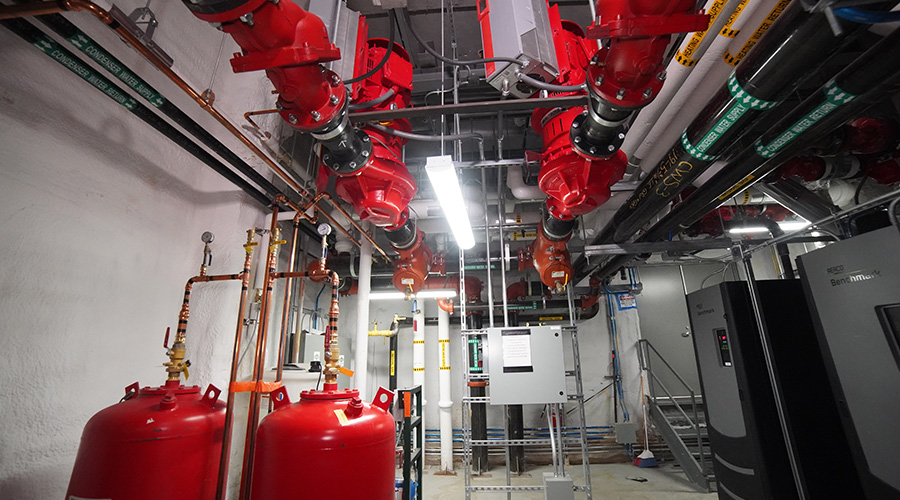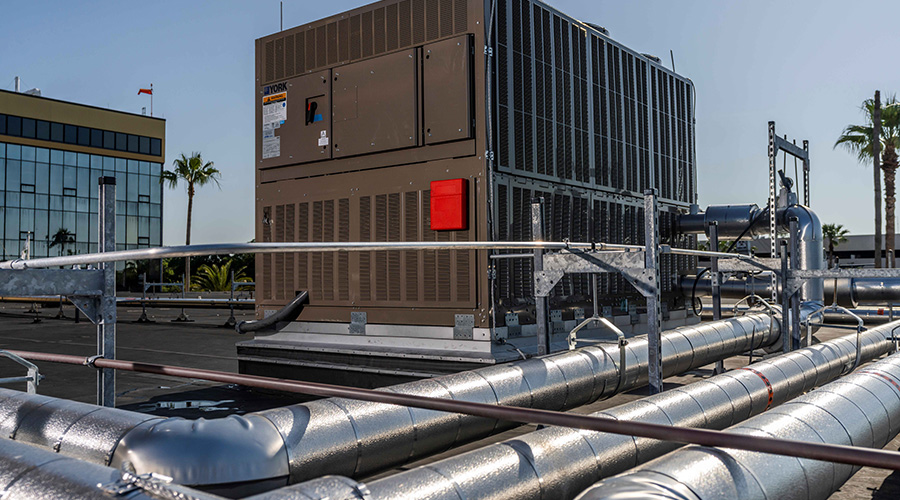Air Distribution Turned Upside Down
Proponents say under-floor air distribution systems can cuts costs and improve
comfort. Critics cite problems. Both are right: The difference is in the details
The design of the modern office building is being shaped by rapidly evolving technology. Facilities should be able to adapt quickly to new technologies and changing business missions. But one system has not kept pace with the growing demands of the modern workplace: conventional cooling technology.
Typical cooling technology used in the vast majority of office buildings is overhead variable air volume, or VAV. With VAV, air is supplied through metal ductwork to terminal units (also called VAV boxes) located in the ceiling. The VAV boxes respond to space thermostats to supply the required amount of conditioned air, usually at 55 degrees Fahrenheit, to maintain space comfort. Air is generally returned to the mechanical room through the space above the ceiling, referred to as the return plenum.
The conventional approach is familiar to owners, designers and contractors; it offers a 30-year track record and proven operational efficiency. But there are two drawbacks. One is low ventilation effectiveness. Because the supply grills and the return grills are in the ceiling, there is a certain amount of short cycling of air; in other words, the supply air goes up the return without doing any work to cool or ventilate the space.
The other disadvantage is the high cost for renovations after occupancy. With the cooling system above the ceiling, and constructed from sheet metal, renovations routinely require the removal of ceiling systems and the installation of new ductwork.
One alternative to the conventional design is drawing a lot of attention: under-floor air distribution. Though relatively new in the United States, under-floor air distribution has been used in Europe for 35 years. Buildings with under-floor air distribution supply conditioned air through a raised floor supply plenum, similar to cooling systems in data centers. Air is supplied to the space through floor air devices that are either manually adjusted by the occupants or controlled automatically by room thermostats. Air is returned from the space generally through a return ceiling plenum.
Unlike data centers that use raised floors as high as three feet, raised floors for under-floor air distribution range in height from 10 to 18 inches. Usually, the raised floor plenum is also used for power and data cabling. The complexity and the amount of data cabling have an impact on the height of the raised floor. For example, most buildings with under-floor air distribution and a single level of under-floor data cable management have a 14-inch raised floor.
Multiple benefits
The use of under-floor air distribution in the United States has grown from less than 1 percent of the office market in 1995 to 6 percent in 2004, according to the Center for the Built Environment at the University of California — Berkeley. Buildings with under-floor air distribution are gaining popularity for several reasons. Occupant comfort in buildings with properly designed under-floor air distribution is higher than in buildings with conventional overhead cooling. Reconfiguring a space for tenants is less costly in buildings with under-floor air distribution. Air devices and the power and data floor boxes are easily moved to accommodate furniture modifications.
What’s more, properly designed under-floor air distribution systems provide more effective ventilation. Introducing supply air at the floor and returning it at the ceiling effectively removes contaminants from the space. Unlike conventional overhead VAV cooling, there is no opportunity for short cycling of the supply air. All the air has to go through the space to get to the return.
At this point, the biggest disadvantage of under-floor air distribution systems is that designers, owners, tenants and contractors aren’t familiar with the approach. A building is a long-term investment, and nobody wants to experiment with a technology they think is unproven.
Another barrier is the misperception that buildings with under-floor air distribution are more expensive. On the contrary, if implemented properly, buildings with under-floor air distribution can be designed and built for virtually the same cost as one with a conventional design. Part of the reason is counterintuitive. When under-floor air distribution is incorporated into a building design by an experienced team, the floor-to-floor height can be reduced by 6 to 12 inches. In a building with conventional overhead cooling, the floor–to-floor heights are usually set by the beam-to-duct interface at the core wall. Supply ductwork, return ductwork and sprinkler pipes compete for space at the core, and generally dictate the amount of space required above the ceiling. A typical ceiling plenum ranges from between 20 and 24 inches below the structural beams.
With under-floor air distribution, there is no supply or return ductwork, which allows the ceiling plenum to be compressed to zero to 8 inches below the structural beams. With under-floor air distribution, the return can actually be in the sidewall of the core, eliminating the need for a return plenum.
It takes commitment by the entire team — owner, designer and contractor — to execute an under-floor air distribution project successfully. If a raised floor and under-floor air distribution is an addition or alternate to a base design, the system is doomed to failure. Integrating under-floor air distribution in a building design affects everything from electrical distribution to structural design. It is a complete building type that needs to be treated as such.
Some buildings with under-floor air distribution constructed in the past several years are performing poorly. In one new building with under-floor air distribution, leakage rates exceeded 70 percent of design air flow, there was poor temperature and humidity control, and the tenants were very dissatisfied. The problem was that the designers, contractor and owner were new to the system. They did not understand key principles in the design of under-floor air distribution, especially the importance of an airtight floor plenum.
The air leaks were sealed, and the leakage rate fell below 5 percent.
Principles of design
Other concerns have arisen about under-floor air distribution systems. In some cases, occupants have complained about being too cold. Conventional overhead VAV uses nominal 55-degree supply air to maintain space conditions in the room at 72 degrees and 50 percent humidity. Cooling air to 55 degrees wrings out moisture and keep the humidity levels acceptable.
Under-floor air distribution systems, on the other hand, use nominal 63-degree supply air. The problem is that, if supply air from the cooling coil in the air handling unit is at 63 degrees, not enough moisture is taken out of the air to keep the humidity within acceptable levels.
The answer is to use a system called coil “face and bypass.” In this system, most of the air is passed through the cooling coil and cooled to 55 degrees to wring out the moisture, but some air bypasses the cooling coil to blend with the 55-degree air, raising the temperature to the required 63 degrees. Outside air should be pretreated to remove humidity to make the face and bypass approach more effective.
The reason for the higher supply air temperature with under-floor air distribution is occupant comfort. Years of research and use in Europe have shown that 63 degrees is the best temperature. Using 55-degree supply air draws occupant complaints about comfort.
It’s also a mistake to use reheat to raise the supply temperature to 63 degrees. It is not code-compliant and will result in huge energy bills.
Another objection to under-floor air distribution systems is that they are too quiet, so that occupants can be distracted by overheard conversations. With under-floor air distribution, the air is delivered at extremely low pressure and low velocity. As such, there is none of the usual background white noise associated with overhead VAV. If speech privacy is important, then a sound masking system needs to be included in the tenant design. These systems are relatively inexpensive and consist of a sound generator and speakers spaced above the ceiling.
Concerns have been expressed about mold and other contaminants. In our firm’s experience, this has not been a problem. Of course, the underfloor plenum must be extensively cleaned after construction, and the cooling system must be properly designed to dehumidify the air. Mold requires moisture or elevated humidity levels. A leaking pipe under the floor is another potential source of moisture. The use of leak detection systems in specific areas is recommended.
There is also concern that under-floor air distribution poses a life-safety risk. If smoke is developing under the floor, it will be distributed into the space. We are not aware of any instance where this has happened. A modern code-compliant office building will have space smoke detectors as well as smoke detectors in the mechanical rooms. There is some talk in the industry about adding smoke detectors under the floor, but so far model codes don’t require them.
Making the decision
So how does a facility executive decide if under-floor air distribution is right for a project? The best applications are for general office space, especially space that is reconfigured frequently. Spaces that are not good candidates for under-floor air distribution include kitchen and food preparation areas, laboratory space, central storage and loading, fitness centers, dining areas and child care centers.
For facility executives who think under-floor air distribution might be right for a project, it is important to seek designers and contractors with relevant experience. It is no harder to successfully design and build an under-floor air distribution project successfully than it is to implement a conventional system. But it is different.
R. Steven Spinazzola, P.E., is vice president of RTKL, an architectural and engineering firm headquartered in Baltimore in Bond Street Wharf.
Related Topics:











